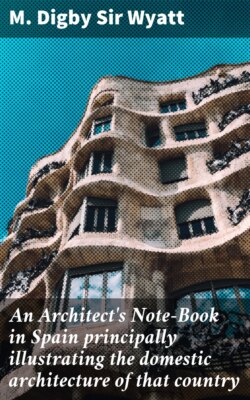Читать книгу An Architect's Note-Book in Spain principally illustrating the domestic architecture of that country - Sir M. Digby Wyatt - Страница 5
На сайте Литреса книга снята с продажи.
BURGOS. THE ARCO DE SANTA MARIA.
ОглавлениеIT is sad to notice how few traces beyond its magnificent Cathedral are left in this, the capital of old Castile, of those "Castellanos rancios y viejos," who once so splendidly represented the pride and power of Spanish chivalry. Of the sixteen golden castles the city bears upon its stately arms how insignificant are the relics? The remains of its walls and bastions attest the many centuries during which it held its own against all comers, Christian or Infidel. Of these walls, our sketch represents a portion in which there is little doubt the Renaissance frontispiece and archway replaced an older and sterner portal, better suited probably for defence than decoration. The legend runs that this façade was executed by the citizens, who had been exhibiting proclivities of far too Communistic a character to be agreeable to so high-handed a sovereign as Charles V., in order to propitiate that potentate, and to commemorate a visit, on his part at least, of a conciliatory character. It would seem, however, that in spite of the loyalty which induced the Burgalese to assign the post of honour (always under the invocation of the "Virgen sin pecado concebida)" to the statue of the King, they took good care to give him for companions Nuño Rasura, and Lain Calvo, whom they had themselves elected in the tenth century to rule over them, and protect their Communal rights. The maintenance of these had been somewhat interfered with by the King of Leon, Fruela II., who had invited the chief citizens to a banquet, and then quietly removed them out of his royal way by summarily putting them all to death. Amongst other statues which adorn this gateway are to be found those of Don Diego Parcelos, the founder of the city in 884, of the Cid—the pride of Spain and especially of Burgos, in which city he was born, and where his bones still rest—and of Fernan Gonzalez who redeemed the district from the yoke of the Kings of Leon, to whom it had been tributary, and who constituted himself and his family its protectors, under the style and title of Condes de Castilla.
The architecture of this frontispiece which gains great importance and much picturesque effect from its association with the bartizans and turrets of the mediæval gateway, has been attributed to Felipe de Borgoña, not apparently on any other grounds than the facts that he was an inhabitant of the city in whom his fellow-citizens felt great pride, and that he was employed upon the "Crucero" of the cathedral at about the period when this grand portal was probably erected.
